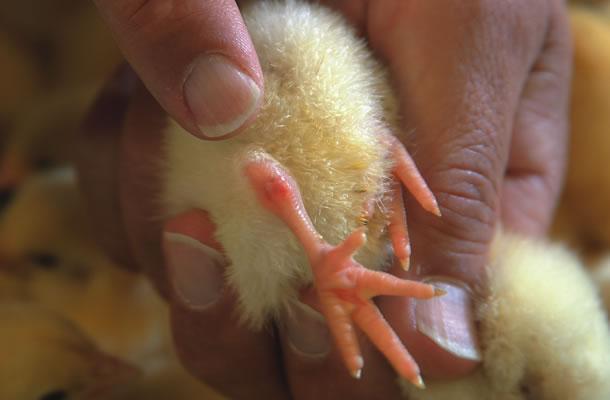Red hocks in day old chicks or poults
Tags: Hatchery management | Whitepaper
, September 11 2015

A day old chick is considered to be of good quality if it has the capacity to grow and mature in line with its genetic potential. The chick is alert and active, with a closed navel and well developed legs that are soft and well hydrated when the toes are extended or stretched. In addition the hocks of a first class chick will show no signs of swelling and be of normal skin colour. Conversely, chicks of inferior quality often show dehydrated legs with red, swollen hocks.
However in practice, many hatcheries do select chicks with minor abnormalities as saleable - and in these saleable batches, we often find chicks with small lesions on the hocks - often called ‘red hocks’.
This condition is attributed to poor conditions in the setter or hatcher. When humidity is set too high, many chicks hatch with an overly large belly, causing them to struggle to leave the shell. As the overheated chick thrusts with its folded legs against the shell, it will - in its bid to be free of its shell as quickly as possible - often thrust too violently, causing damage to its hocks in the process.
But do red hocks actually influence welfare and growth performance in the farm? In a small scale experiment, Pas Reform analysed the behaviour and growth of poor quality chicks with red hocks, black dots on the navel and a large yolk sac (De Jong et al, 2004).
In a commercial hatchery environment, 96 good quality chicks were selected as a control group, with an equal number of poor quality chicks. The chicks were housed on wood shavings in groups of four - two good quality chicks and two poor quality chicks - per pen. Both groups were studied and compared for two aspects of welfare (behaviour, walking ability) and for growth in relation to production, between days 1 - 8 and days 35 - 42 of age.
This study established that good quality day old chicks suffer less from leg weakness than poor quality chicks - and that to avoid the incidence of chicks with red hocks, large yolk sacs and bad navels, incubation conditions should support optimal embryonic development.
Advice
To optimise results with day old chicks:
- Decrease relative humidity in the setter if many chicks (> 20 %) have a thick belly
- Increase setter temperature by 0.2 ˚F, if red hocks are showing in combination with late hatches and many chicks (> 20 %) also have a thick belly.
- Decrease temperature in the hatcher by 0.2 ˚F if more than 15% of saleable chicks have red hocks.
Significant differences between poor quality chicks, good quality chicks and broilers raised from them.
| Parameter | Poor quality chicks | Good quality chicks | P-value (D) |
| Relative growth week 1 (%) (A) | 215.4 | 225.1 | 0.03 |
| Gait score day 39 (B) | 0.84 | 0.49 | 0.01 |
| Step with (cm) at day 39 | 9.55 | 8.61 | 0.006 |
| Latency-to-lie at day 40 (min) (C) | 210 | 263 | 0.06 |
Ad. A: Relative growth (RG) is calculated as follows: RG = 100* (weight day 7 - weight day 0)/(weight day 0)
Ad. B: Optimum gait score is zero when chicks walk normally for at least 10 steps (Dawkins, 2004)
Ad. C: The latency-to-lie test measures the time in consecutive minutes that the broiler is willing to stand.
Ad. D: P-values < 0.05 represent a significant difference between good and poor quality chicks.